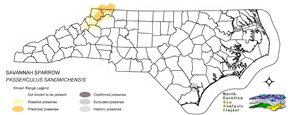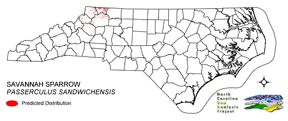
| Taxa: |
| Order: |
| Family: |
| Aves |
| Passeriformes |
| Emberizidae |
| NatureServe Global Rank: |
| NatureServe State (NC) Rank: |
| G5 |
| S1B,S5N |
| Federal Status: |
| NC State Status: |
| --- |
| SR |


| Land Unit |
| US Fish & Wildlife Service |
| US Forest Service |
| US National Park Service |
| US Department of Defense |
| NC State Parks |
| NC University System |
| NC Wildlife Res. Com. |
| NC Forest Service |
| NC Div. of Coastal Mgmt. |
| Local Governments |
| Non-Governmental Org. |
| Other Public Lands |
| Private Lands |
| GAP Status 1-2 |
| All Protected Lands |
| Statewide |
| Hectares |
| 0.00 |
| 300.33 |
| 0.00 |
| 217.26 |
| 344.88 |
| 0.00 |
| 119.07 |
| 2.97 |
| 0.00 |
| 0.00 |
| 24.39 |
| 0.00 |
| 29,443.95 |
| 705.60 |
| 1,008.90 |
| 30,452.85 |
| Acres |
| 0.00 |
| 742.13 |
| 0.00 |
| 536.86 |
| 852.22 |
| 0.00 |
| 294.23 |
| 7.34 |
| 0.00 |
| 0.00 |
| 60.27 |
| 0.00 |
| 72,757.57 |
| 1,743.58 |
| 2,493.05 |
| 75,250.62 |
| % of Dist. on |
| Prot. Lands |
| 0.0 % |
| 29.8 % |
| 0.0 % |
| 21.5 % |
| 34.2 % |
| 0.0 % |
| 11.8 % |
| 0.3 % |
| 0.0 % |
| 2.4 % |
| 2.4 % |
| 0.0 % |
| 0.0 % |
| 69.9 % |
| ----- |
| ----- |
| % of Dist. on |
| All Lands |
| 0.0 % |
| 1.0 % |
| 0.0 % |
| 0.7 % |
| 1.1 % |
| 0.0 % |
| 0.4 % |
| < 0.1 % |
| 0.0 % |
| 0.0 % |
| < 0.1 % |
| 0.0 % |
| 96.7 % |
| 2.3 % |
| ----- |
| ----- |
|
Not known or thought to nest within the state, either accidentally or hypothetically (Pearson 1959, Potter et al. 1980, Stupka 1963). A few recent nesting records exist for east Tennessee, making it possible that the species is expanding its range southward along the Appalachian Mountains (Knight 1989). In Tennessee, found in broad valleys, in open grassy fields such as hayfields or pastures (Nicholson 1997). Elsewhere in its range, found in similar habitat such as occurs along roadsides, in coastal grasslands, sedge bogs, and saltmarsh edges. Avoids dense tree cover (Rising and Beadle 1996). Feeds from the ground or tips of branches (Rising and Beadle 1996). NATURE SERVE GLOBAL HABITAT COMMENTS: Habitat varies geographically, includes open areas, especially grasslands, tundra, meadows, bogs, farmlands, grassy areas with scattered bushes, and marshes, including salt marshes in the BELDINGI and ROSTRATUS groups (Subtropical and Temperate zones) (AOU 1983). Nests on the ground in a natural depression or scrape. Nest generally is well concealed by over-arching grasses or vines. |
| Code | Name | Description | NC Natural Heritage Program Equivalent |
| 180 | Agricultural Crop Fields | Farm fields used for row crops. | No equivalent |
| 205 | Agricultural Pasture/Hay and Natural Herbaceous | Farm fields used for pasture grass or hay production, as well as old fields dominated by native and exotic grasses. | No equivalent |
| 523 | Grassy Bald | High Elevation grassy balds including Pennsylvania sedge, mountain oatgrass, as well as shrubby areas dominated by Alleghany and smooth blackberry. | Grassy Bald |
|
Johnson, D.H., and L.D. Igl. 1995. Contributions of the Conservation Reserve Program to populations of breeding birds in North Dakota. Wilson Bulletin 107:709-718.
Ridgway, R. 1901. The birds of North and Middle America. Part I. U.S. National Museum Bulletin 50. California Department of Fish and Game. 1990. 1989 annual report on the status of California's state listed threatened and endangered plants and animals. 188 pp. Nicholson CP. 1997. Atlas of the breeding birds of Tennessee. Knoxville: University of Tennessee Press. Knight, R.L. 1989. Second Tennessee breeding record of Savannah Sparrow, with comments on its expansion into the southern Appalachians. Migrant 60:69-71. Stupka A 1963. Notes on the birds of the Great Smoky Mountains National Park. Knoxville: The University of Tennessee Press. Oberholser, H.C. 1974. The bird life of Texas. 2 vols. Univ. of Texas Press, Austin. Pearson, T.G. 1959. Birds of North Carolina. Raleigh, NC: Bynum Printing Company. Godfrey, W.E. 1966. The birds of Canada. National Museums of Canada. Ottawa. 428 pp. Johnson, R.G., and S.A. Temple. 1990. Nest predation and brood parasitism of tallgrass prairie birds. Journal of Wildlife Management 54:106-111. Harrison, H.H. 1975. A field guide to bird's nests in the U.S. east of the Mississippi River. Houghton Mifflin Company, Boston, Massachusetts. 257 p. Harrison, C. 1978. A field guide to the nests, eggs and nestlings of North American birds. Collins, Cleveland, Ohio. Potter, E. F., J. F. Parnell, and R. P. Teulings. 1980. Birds of the Carolinas. Univ. North Carolina Press, Chapel Hill. 408 pp. Terres, J.K. 1980. The Audubon Society encyclopedia of North American birds. Alfred A. Knopf, New York. American Ornithologists' Union (AOU), Committee on Classification and Nomenclature. 1983. Check-list of North American Birds. Sixth Edition. American Ornithologists' Union, Allen Press, Inc., Lawrence, Kansas. National Geographic Society (NGS). 1983. Field guide to the birds of North America. National Geographic Society, Washington, D.C. Dwight, J. 1895. The Ipswich sparrow. 56 pp. Biosystems Analysis, Inc. 1989. Endangered Species Alert Program Manual:Species Accounts and Procedures. Southern California Edison Environmental Affairs Division. Rising, J. D. 1987. Geographic variation of sexual dimorphism in size of savannah sparrows:a test of hypotheses. Evolution 41:514-524. Johnson, S.R., and D.R. Herter. 1989. The birds of the Beaufort Sea. BP Exploration (Alaska) Inc., Anchorage, Alaska. 372 pp. Williams, J. B. 1987. Field metabolism and food consumption of savannah sparrows during the breeding season.Auk 104:277-289. Pylypec, B. 1991. Impacts of fire on bird populations in a fescue prairie. Canadian Field-Naturalist 105(3):346-349. Zink, R. K., et al. 1991. Mitochondrial DNA variation and the taxonomic status of the large-billed savannah sparrow. Condor 93:1016-1019. |
For more information please contact them at:
NC-GAP Analysis Project
Dept. of Zoology, NCSU
Campus Box 7617
Raleigh, NC 27695-7617
(919) 513-2853
www.basic.ncsu.edu/ncgap